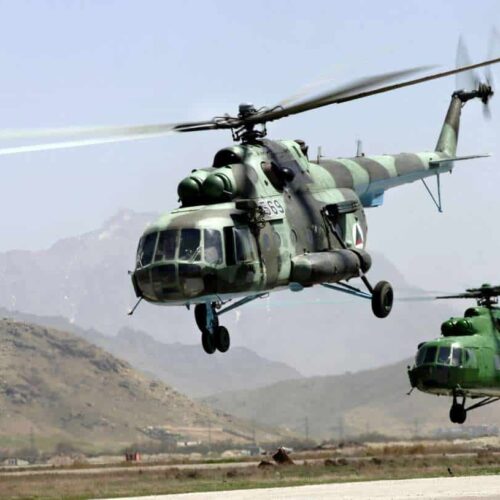Introduction
If military operations in the early years of Iraq and Afghanistan justified the use of sole-sourcing contracting for support services, then the drawdown in Iraq and Afghanistan created a new justification for steering contracts to a single bidder: the need to quickly equip the militaries there.
The rush to equip the new military forces in these countries was used to justify sole-source procurements for a host of weapons and equipment, particularly for what is called “non-standard” equipment—in this case, Russian. Those countries, so the argument went, were more familiar with Russian equipment. Even in Afghanistan, a country which fought off a Soviet occupation in the 1980s, U.S. officials argued that the Northern Alliance and Afghan pilots were more familiar with Russian helicopters, which are regarded as rugged and reliable.
Today, U.S. contracts for Russian equipment, used primarily to buy Russian-built Mi-17 helicopters for Iraq, Afghanistan and Pakistan, have topped $1 billion and have almost all been sole-source or non-competitive contracts. They include:
- A non-competed $89 million contract awarded to General Dynamics Ordnance and Tactical Systems to buy three VIP Russian helicopters for Afghanistan’s president
- A $322 million sole-source deal to buy 22 helicopters for Iraq
- Most recently, another sole-source contract, which could be worth almost $900 million, to supply Russian helicopters for Afghanistan
The Pentagon’s sole-source buying of Russian helicopters has upset some lawmakers.
Six members of the congressional delegation from Connecticut, home to Sikorsky Aircraft, wrote to the Pentagon to protest the Russian purchase. “Particularly in light of the great commitment the United States is making to Afghanistan, rather than procuring Russian helicopters with unclear reliability and cost, we believe it is only prudent to consider proposals from U.S. manufacturers, employing American workers, with a history of providing the Defense Department with the best equipment at the best value to the U.S. taxpayer,” the 2010 letter said.
Sen. Richard Shelby, R-Ala., a longtime advocate of defense interests, also questioned the choice of Russian helicopters. “The program appears to be an ad hoc procurement process with inadequate oversight,” he wrote to the Pentagon. “The program is undefined, delayed, and simply not a good use of taxpayer funds.”
In 2009, the Navy eventually held a rare competition to buy four Mi-17 helicopters for Afghanistan and opened it up for bidders, awarding a $43.5 million contract to a defense firm in Shelby’s home state to deliver four Mi-17s. The Navy was preparing to hold another competition for 21 Mi-17s in 2011, when the Pentagon decided to hand the responsibility to a newly created Army office, which canceled the competition and moved into sole-source negotiations with Rosoboronexport, the Russian state arms agency. Rosoboronexport had only recently been removed from the list of companies sanctioned by the U.S. State Department for violating U.S. laws prohibiting the sale of weapons to Iran and Syria.
The Army moved forward with plans to sole-source a $375 million contract to the Russian arms agency, now arguing that it was the only legitimate seller of Russian armaments. A number of American companies lodged protests against the award, including Sikorsky, which argued that the U.S. should have considered American aircraft, and Arinc, which, after having won its own sole source for Russian helicopters, now argued it was being disadvantaged because the contract required working with Rosoboronexport. The GAO, however, dismissed the protests.
According to a copy of the contract provided to iWatch News, it includes another $550 million for additional helicopters, which would bring the total contract to nearly $1 billion.
The head of the office in charge of the acquisition said that even though the main contract went to Russia, the installation of Western cockpits, about $3 million per helicopter, would go to a U.S. firm. “We could have easily left these aircraft in Russia and done the mod’s there,” Bert Vergez, the head of the Army’s Non-Standard Rotary Wing Aircraft office, told The Huntsville Times. “I thought it made sense to bring that work here.”
In fact, Vergez brought the work to Huntsville, under a non-competitive award as part of an umbrella contract called the “Prototype Integration Facility,” a 10-year, $1.1 billion award to a joint venture of Yulista Management Services, Inc. and Science and Engineering Services, Inc.
The Pentagon defended the decision and denied reports, made by another company, that Rosoboronexport was charging the U.S. government twice what it paid for the choppers. “We have no information concerning the nature of the alleged reports” about price inflation. “The contracting office determined that the costs were fair and reasonable,” the Pentagon said.
There is, however, an ongoing inspector general investigation looking at Russian helicopter procurement, examining “whether DoD official properly and effectively managed the acquisition and support of Non-Standard Rotary Wing Aircraft, such as the Russian Mi-17.”
Next: Sole-sourcing, from helicopters to air tankers
Read more in National Security
National Security
Pentagon’s accounting shambles may cost an additional $1 billion
DOD had pledged clean books by 2017, but Panetta wants deadline moved up three years
National Security
Congressional reform and interoperability still plagued by systematic problems
Bipartisan Policy Center report says some post-9/11 recommendations haven’t been implemented

Join the conversation
Show Comments